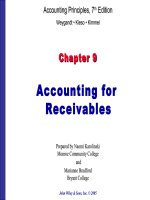Accounting principles 7th kieso kimel chapter 08
Bạn đang xem bản rút gọn của tài liệu. Xem và tải ngay bản đầy đủ của tài liệu tại đây (1.9 MB, 49 trang )
Accounting Principles, 7th Edition
Weygandt • Kieso • Kimmel
Chapter 8
Inter n al Control and
Cash
Prepared by Naomi Karolinski
Monroe Community College
and
Marianne Bradford
Bryant College
John Wiley & Sons, Inc. © 2005
CHAPTER 8
INTERNAL CONTROL AND CASH
After studying this chapter, you should be able to:
1 Define internal control.
2 Identify the principles of internal control.
3 Explain the applications of internal control principles to
cash receipts.
4 Explain the applications of internal control principles to
cash disbursements.
5 Describe the operation of a petty cash fund.
6 Indicate the control features of a bank account.
7 Prepare a bank reconciliation.
8 Explain the reporting of cash.
INTERNAL CONTROL
STUDY OBJECTIVE 1
Internal Control
1. Safeguards an organization’s assets
2. Enhances the accuracy and
reliability of accounting records
PRINCIPLES OF INTERNAL
CONTROL
STUDY OBJECTIVE 2
PRINCIPLES OF
INTERNAL
CONTROL
• Establishment of responsibility:
• most effective when only one person is responsible
for a given task
• Segregation of duties:
• the work of one employee should provide a
reliable basis for evaluating the work of
another employee
• Documentation procedures:
• documents provide evidence that transactions and
events have occurred
PRINCIPLES OF
INTERNAL
CONTROL
• Physical, mechanical, and electronic controls:
safeguarding of assets and enhancing accuracy and
reliability of the accounting records.
• Independent internal verification:
the review, comparison, and reconciliation of
information from two sources.
• Other controls:
bonding of employees who handle cash, rotating
employee’s duties, and requiring employees to take
vacations.
PHYSICAL, MECHANICAL,
AND ELECTRONIC
CONTROLS
Locked warehouses and storage cabinets for
inventories and records
Safes, vaults, and safety deposit boxes for
cash and business papers
Time clocks for recording time worked
Computer facilities with pass key access
Alarms to prevent break-ins
Television monitors and garment sensors to
deter theft
PHYSICAL, MECHANICAL,
AND ELECTRONIC CONTROLS
INDEPENDENT
INTERNAL
VERIFICATION
Maximum benefit
Independent internal verification:
1 Made on periodic or surprise basis
2 Should be done by someone who is
independent of the employee responsible for
the information
3 Report discrepancies and exceptions to a
management level that can take appropriate
corrective action
COMPARISON OF SEGREGATION OF DUTIES
PRINCIPLE WITH INDEPENDENT INTERNAL
VERIFICATION PRINCIPLE
LIMITATIONS OF INTERNAL
CONTROL
Costs of establishing control procedures
should not exceed their expected benefits
The human element is an important factor in every
system of internal control.
• A good system can become ineffective through
employee fatigue, carelessness, or indifference.
Collusion may result.
• Two or more individuals work together to get around
prescribed controls and may significantly impair the
effectiveness of a system.
CASH
Cash
• Coins, currency, checks, money orders,
and money on hand or on deposit at a
bank or similar depository
Internal control over cash is imperative
• Safeguards cash and assure the accuracy
of the accounting records for cash
CONTROL OVER CASH
RECEIPTS
STUDY OBJECTIVE 3
• Only designated personnel should be
authorized to handle or have access to cash
receipts.
• Different individuals should:
1 receive cash
2 record cash receipt transactions
3 have custody of cash
CONTROL OVER
CASH RECEIPTS
• Documents should include:
1 Remittance advices
2 Cash register tapes
3 Deposit slips
• Cash should be stored in safes and bank vaults
• Access to storage areas should be limited to
authorized personnel
• Cash registers should be used in executing
over-the-counter receipts
Internal control is used in a business to
enhance the accuracy and reliability of its
accounting
and to:
a. safeguardrecords
its assets.
b. prevent fraud.
c. produce correct financial statements.
d. deter employee dishonesty.
Internal control is used in a business to
enhance the accuracy and reliability of its
accounting records and to:
a. safeguard its assets.
b. prevent fraud.
c. produce correct financial statements.
d. deter employee dishonesty.
CONTROL OVER
CASH RECEIPTS
•
•
•
Daily cash counts and daily comparisons of total receipts.
All personnel who handle cash receipts should be bonded
and required to take vacations.
Control of over-the-counter receipts is centered on cash
registers that are visible to customers.
CONTROL OVER
CASH
DISBURSEMENTS
STUDY OBJECTIVE 4
• Payments are made by check rather
than by cash, except for petty cash
transactions.
• Only specified individuals should
be authorized to sign checks.
• Different departments or individuals
should be assigned the duties of approving
an item for payment and paying it.
CONTROL OVER
CASH
DISBURSEMENTS
Prenumbered
checks should be used and
each check should be supported by an
approved invoice or other document.
Blank checks should be stored in a safe.
1 Access should be restricted to authorized
personnel.
2 A check writer machine should be used
to imprint the amount on the check in
indelible ink.
CONTROL OVER
CASH
DISBURSEMENTS
Each check should be compared with the approved invoice before it is issued.
Following payment, the approved invoice should be stamped “PAID”.
d
i
a
P
VOUCHER
SYSTEM
The voucher system
Is often used to enhance the internal control over
cash disbursements.
Is an extensive network of approvals by
authorized individuals acting independently to
ensure that all disbursements by check are
proper.
A voucher is an authorization form prepared
for each expenditure.
Vouchers are recorded in a journal called the
voucher register.
ELECTRONIC FUNDS
TRANSFER SYSTEM
• Checks processing is expensive
• New methods are being developed to transfer
funds among parties without the use of paper
• Electronic Funds Transfer (EFT) System
A disbursement system that
uses wire, telephone, telegraph, or
computer to transfer cash from one
location to another









